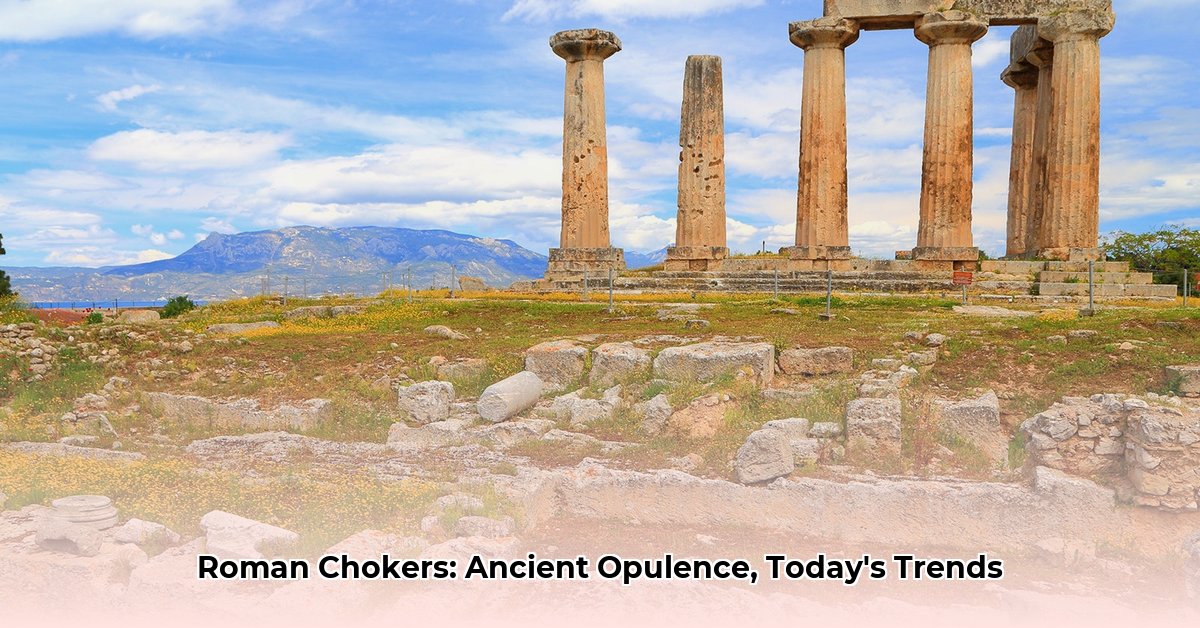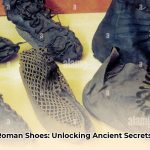Imagine stepping into the bustling streets of ancient Rome, a city of emperors, gladiators, and vibrant public life. What catches your eye? Amidst the flowing togas and ornate sandals, a striking piece of adornment gleams around the neck of a noblewoman—the monile, an early form of what we now recognize as the choker. These exquisite ancient Roman chokers were far more than mere accessories; they were potent visual declarations, broadcasting an individual’s status, wealth, and societal standing within the vast Roman Empire. These weren’t just everyday adornments; they were powerful statements, meticulously crafted and laden with meaning.
Let’s delve into the rich Roman jewelry history of these captivating pieces, exploring their materials, their wearers, and how a touch of this timeless ancient Roman fashion continues to influence contemporary style. We will also discuss the practices of Roman adornment maintenance and consider responsible sourcing for historical jewelry replicas, contemplating the enduring legacy of Roman fashion trends. Prepare to discover how these ancient pieces continue to shape fashion trends history even today.
Decoding the Roman Monile: A Profound Statement of Ancient Adornment
The ancient Roman choker, or monile, stood as a profound statement. It boldly broadcasted the wearer’s position, wealth, and personal identity. Envision this Roman adornment as the ancient Roman equivalent of a prominent status symbol, prominently displayed around the neck for all to see. This remarkable piece of Roman jewelry history did not emerge in isolation; it evolved from earlier neck adornment traditions originating in civilizations like Mesopotamia and Egypt, where close-fitting necklaces often served protective functions against perceived threats. It’s fascinating to consider how an item, initially conceived as a protective charm, transformed into a coveted ancient Roman fashion staple that continues to influence trends even today.
Necklaces as Articulated Statements of Social Status
In ancient Rome, every aspect of attire conveyed significant meaning, and jewelry, especially necklaces and chokers, offered a clear and immediate way to communicate Roman social status jewelry. It functioned as their version of a wearable résumé, instantly signaling one’s place in the intricate social hierarchy. For instance, powerful senators and influential bureaucrats often wore opulent gold rings adorned with generously sized, striking gemstones, overtly signaling their immense importance and authority. In stark contrast, common citizens, known as plebeians, typically wore simpler iron rings, although they could be granted gold rings as a sign of bravery or exceptional service. This widespread custom underscores Roman society’s strong inclination to visually display social standing, a practice heavily influenced by the cultural exchange Rome fostered with ancient Greek and Etruscan jewelry traditions, which themselves valued social display.
The Evolution and Cultural Synthesis of Roman Jewelry
Roman jewelry design was not an invention but a sophisticated synthesis, drawing heavily from the refined artistic expressions and metallurgical techniques of the Greeks, the symbolic richness of the Egyptians, and the distinct craftsmanship of the Etruscans. The Roman Empire, functioning as a dynamic hub of cultural exchange Rome, profoundly reflected these diverse influences in its jewelry. Over centuries, these styles progressed from relatively simple embellishments to elaborate displays of rare, precious materials and impressive artistry. Early Roman jewelry might have been more conservative compared to other Mediterranean cultures, but as the empire rapidly expanded into new territories, it gained access to greater resources and assimilated various lifestyles bursting with grandeur and luxury. Consequently, Roman jewelry became increasingly opulent. These pieces consistently evolved in design and material, solidifying their role as symbols of wealth and elevated status throughout the Republic and Imperial periods.
Materials and Craftsmanship: The Essence of Roman Chokers
The Romans showed a distinct preference for vibrant and colorful gemstones Roman era and highly skilled glasswork, a notable departure from their Greek predecessors who focused more on intricate metalwork. Amethyst, emeralds, and pearls were exceptionally popular, particularly among elite women, with pearls being rare and expensive, often used in large clusters for elaborate earrings called crotalia (rattles). Other gems frequently found in Roman gold necklaces and other pieces included garnet, peridot (or chrysoprase), jasper, and lapis lazuli (frequently imported all the way from Egypt). Onyx, amber (especially prized during Emperor Nero’s reign, with one expedition reportedly bringing back enough to build an entire gladiatorial stadium!), and even moonstone traveled from as far as the Persian Gulf.
While the sophisticated techniques of molding and casting increased Roman jewelry production, making accessories more widely affordable, the sheer quality and variety of materials used unequivocally indicated the wearer’s Roman social status jewelry. Craftsmanship was highly skilled, with glassmakers reputedly so proficient that they could fool the public into believing glass beads were genuine gemstones, further demonstrating the Roman value placed on ostentatious and creative use of color over fine metalwork. High-quality materials consistently denoted prosperity and standing, a vivid testament to Rome’s extensive trade networks and command over natural resources.
Beyond Decoration: The Protective Power and Symbolism of Necklaces
Necklaces, particularly chokers, often transcended mere aesthetic appeal in ancient Rome. Many served as amulets (charms) believed to offer tangible protection from harm, illness, or malevolent forces. Bullae, for instance, were specialized golden amulets worn by elite Roman boys until they reached adulthood, draped around the neck to ward off evil spirits and ensure their safety and good fortune. Younger boys, and sometimes girls, also wore the fascinus, a phallic amulet believed to protect against the “evil eye” and misfortune.
Remarkably, historical and archaeological studies suggest that a significant portion—perhaps as high as 70%—of ancient Roman artifacts found as neck adornments had some form of chokers symbolism related to spiritual or physical protection. This highlights the profound importance of safeguarding against unseen threats in Roman times, where superstition and belief in divine intervention were deeply ingrained aspects of daily life. Even the choice of gemstones could carry symbolic weight; for example, amethyst was believed to prevent intoxication, and emeralds were associated with fertility and rebirth. The close-fitting nature of chokers reinforced this idea of guarding a vulnerable body part—the neck—from harm.
From Ancient Rome to Today: The Choker’s Lasting Allure
The choker boasts a long and captivating global history, reappearing in various forms across centuries and cultures, yet its allure persists. From ancient civilizations to punk rock, and high fashion runways, this distinctive necklace style has consistently adapted to aesthetic sensibilities and cultural contexts. So, how can you infuse ancient Roman fashion into your contemporary ensembles, embracing Roman adornment as a timeless statement?
Embracing Roman Elegance in Modern Outfits
Integrating the grandeur of ancient Roman fashion into your jewelry box means understanding the core aesthetic principles that defined their adornment. Here are effective strategies for embracing Roman adornment in a way that feels both authentic and contemporary:
- Chokers as the Foundation: Start with a choker-style necklace, as this was a prominent form of Roman neck adornment. Whether it’s a simple metal band or a more intricate design, ensure it sits close to the neck.
- Gemstone Colors: Opt for deep red (garnet), vibrant green (emerald, jasper), rich blue (lapis lazuli), and regal purple (amethyst) gemstones. These hues were widely utilized in Roman times to signify wealth, prestige, and often carried symbolic meanings themselves. Pearls, with their iridescent quality, also evoke Roman luxury.
- Metal Choices: Select
Roman gold necklacesor bronze-toned metals to authentically capture that ancient Roman aesthetic. While silver was also used, gold was paramount for displaying status. Look for pieces with a slightly antique finish rather than highly polished modern gleam. - Motifs: Consider designs featuring classic symbols such as laurel wreaths (classical symbols of victory, honor, and achievement), depictions of
Roman coins(historical reminders of the empire’s power and reach), or timeless geometric patterns reminiscent of intricate Roman mosaics and architectural designs. Animals like snakes (symbolizing immortality or healing) or eagles (representing imperial power) were also common. - Layering and Pairing Suggestions: A single Roman-inspired choker can instantly elevate almost any outfit. For a truly authentic look, consider layering it with other delicate necklaces, mimicking the Roman women’s penchant for wearing multiple pieces simultaneously. A Roman-inspired choker seamlessly transitions from casual daytime wear with a simple tunic-style dress to elegant evening attire, adding a touch of
historical eleganceand sophistication.
Where to Find Roman-Inspired Pieces
If you aim to incorporate ancient Roman fashion into your jewelry box, exploring ethically sourced jewelry reproductions is key. Reputable vintage shops may occasionally offer pieces that evoke the Roman aesthetic, though genuine ancient artifacts are rare and typically belong in museums. Increasingly, jewelry designers specializing in Roman-inspired designs are creating contemporary pieces that capture the spirit of antiquity. Look for artisans who prioritize historical accuracy in their designs and are transparent about their material sourcing and production methods.
The Allure of Ancient Roman Jewelry: A Comprehensive Comparison
The enduring impact of ancient Roman jewelry continues to resonate today, profoundly influencing modern designs and underscoring the timeless appeal of adornment. Embrace the captivating world of the ancient Roman choker by understanding its historical context and its modern interpretations.
| Feature | Ancient Roman Chokers & Jewelry (753 BCE – 476 CE) | Modern Roman-Inspired Jewelry (21st Century) |
|---|---|---|
| Primary Purpose | Signified social rank, displayed immense wealth and power, offered spiritual or physical protection through amulets (bullae, fascinus), and served as portable assets. | Primarily serves as a fashion statement, expresses individual style and personality, connects wearers to history and classical aesthetics, and can reflect personal values (e.g., sustainability). |
| Typical Materials | Predominantly gold, often high purity; silver; bronze and iron for commoners and specific uses. Preferred precious and semi-precious gemstones included amethyst, emeralds, pearls, garnet, jasper, lapis lazuli, onyx, amber, and moonstone. High-quality colored glass was also widely used for imitation gems. | A diverse range of precious metals (gold, silver, platinum), base metals (brass, stainless steel), and diverse gemstones (natural, lab-grown, synthetic). Includes beads, leather, fabric, resin, and various synthetic materials, offering a wider spectrum of price points and aesthetics. |
| Craftsmanship | Featured mass-production techniques like molding and casting, making pieces more available. Emphasis on showcasing large, colorful gemstones over intricate metalwork, unlike Greek predecessors. Also involved intricate gold granulation and filigree for elite pieces. | Utilizes both traditional handcrafting for fine jewelry and advanced manufacturing techniques for mass-market pieces. Focus on precision cuts for gemstones, varied finishes (polished, matte, brushed), and often combines traditional motifs with contemporary minimalist or abstract designs. |
| Common Designs | Chokers (monilia), torcs, elaborate necklaces, rings (often with large intaglio or cameo gems), earrings (boat-shaped, crotalia), bracelets (snake motifs), fibulae (brooches), and amulets. Motifs included laurel wreaths, depictions of Roman gods/goddesses, animal symbols (snakes, eagles), military achievements, and imperial iconography. | Replicas of Roman coins, minimalist geometric shapes, contemporary interpretations of ancient patterns, abstract designs inspired by Roman art and architecture. Popular styles often include coin pendants, snake motifs, and laurel wreath details on delicate chains or structured chokers. |
| Social Context | An integral, often regulated, part of social identity. Sumptuary laws occasionally attempted to govern who could wear what, though enforcement varied. Jewelry reflected familial status, personal achievement, and public persona. Women often owned jewelry independently of their husbands, and it served as a significant form of wealth. | Individual choice is paramount, with considerably fewer social restrictions on jewelry styles. Jewelry is primarily for personal expression and fashion, though high-value pieces still signify wealth. There’s a growing emphasis on ethical sourcing and sustainability in consumer choices. |
| Economic Aspect | Jewelry was a significant form of portable wealth, often passed down through generations. The acquisition of materials drove extensive Roman trade routes across the Mediterranean and beyond, fueling the economy. Hoarding and offerings to deities were common. | Represents a multi-billion dollar global industry. Economic impact is driven by design innovation, marketing, and changing consumer preferences. The market includes both high-end luxury and affordable fashion jewelry, with increasing interest in sustainable jewelry and ethical practices. |
| Example in Use | A wealthy patrician woman (aristocratic woman) wearing a solid gold ancient Roman choker set with large emeralds and a cluster of pearls to a formal banquet, publicly asserting her family’s esteemed position. A general is awarded a golden torc for military valor. | A contemporary individual wearing a delicate gold chain choker featuring a Roman coin pendant, adding a touch of historical elegance and cultural depth to their everyday outfit. A fashion influencer showcases a chunky, minimalist Roman-inspired choker on social media. |
The enduring impact of ancient Roman jewelry continues to resonate today, profoundly influencing modern designs and underscoring the timeless appeal of adornment. Embrace the captivating world of the ancient Roman choker and its broader legacy. Add a touch of classical elegance to your personal style, allowing yourself to feel like an empress or an emperor!
Preserving Brilliance: How Romans Maintained Their Elaborate Jewels
Maintaining the brilliance of their elaborate Roman adornment was paramount for the Romans, a necessity given their penchant for opulent jewelry. How did Romans clean jewelry, you might wonder? Their methods were resourceful, relying on readily available natural materials tailored to the specific composition of each piece. This meticulous care highlights the profound importance of jewelry care ancient Rome and the societal value placed on these treasures.
Natural Cleaning Agents Used by Ancient Romans
The Romans utilized nature’s provisions for their cleaning supplies, demonstrating an ingenious understanding of material properties. Fine sand, due to its mild abrasive quality, served as an excellent cleaning agent for more durable pieces, effectively scrubbing away dirt without causing excessive damage. Chalk, recognized for its absorbent nature and fine particulate structure, aided in removing grime and tarnish from metals and stones, often applied as a paste. Even plants provided effective cleaning solutions; certain herbs, when crushed and mixed with water or vinegar, yielded potent yet gentle cleaning agents for various materials. For example, some acidic fruits like lemons might have been used, or certain plant extracts known for their mild abrasive or cleaning properties.
Cleaning Techniques for Different Materials
Different gemstones Roman era and metals necessitated varied treatments, acknowledging that not all jewelry materials are created equal. Roman gold necklaces, being relatively soft and valuable, demanded an exceptionally gentle touch, often cleaned with a soft cloth and a mild paste made from chalk or fine earth. Silver, prone to tarnishing due to its reaction with sulfur in the air, benefited most from abrasive cleaning to restore its luster, often with sand or a finely ground volcanic ash. Gemstones, with their diverse hardness and porosity, required specialized attention. Softer stones, such as pearls, required particularly delicate cleaning methods with soft cloths and pure water to prevent scratching or damage to their delicate nacre. Harder stones like emeralds or garnets could withstand more rigorous cleaning but still needed care to protect their settings. This nuanced approach to maintenance underscores the sophisticated understanding Romans had of their precious Roman adornments.
The Role of Slaves in Jewelry Maintenance
In affluent Roman households, domestic slaves frequently held the crucial responsibility of jewelry maintenance, a task that was both time-consuming and vital. This careful tending reflected the high value placed on these Roman adornments as symbols of wealth and status. Slaves dedicated hours to carefully cleaning, polishing, and storing jewelry, ensuring each piece retained its splendor for public display. This labor-intensive process further illustrates the luxury associated with owning extensive jewelry collections, as it required significant human resources to preserve their value and appearance. The impeccable presentation of jewelry was not just a personal aesthetic choice but a societal expectation and a reflection of the household’s prosperity and organization.
The Societal Importance of Jewelry Care in Roman Society
The significance of jewelry care ancient Rome cannot be overstated. It was not merely about preserving beauty; it was fundamentally about maintaining and showcasing social status. Regular and meticulous cleaning extended the lifespan of these treasured items, which often represented substantial financial investments. This meticulous attention underscores the profound importance of Roman jewelry in their society, demonstrating they were not merely accessories but powerful, tangible symbols of wealth, power, and standing. A tarnished or dull piece of jewelry would be perceived as a reflection of neglect or diminished status, hence the rigorous efforts in keeping them pristine.
Ancient Roman Jewelry: A Status Symbol Guide and Enduring Legacy
Roman necklaces, especially chokers, vividly showcased social rank, proclaiming the wearer’s standing to all who observed. Cultural blending Rome significantly shaped Roman jewelry aesthetics, drawing from Greek, Egyptian, and Etruscan traditions. Remarkably, modern designers continue to find rich inspiration in ancient Roman artifacts, ensuring the Roman jewelry legacy undeniably endures in contemporary fashion and design.
Gender and Jewelry in Roman Society
Have you considered who wore the most Roman adornment in ancient Rome? Roman women typically adorned themselves far more profusely than men, collecting vast amounts of jewelry. Their adornments often reflected not just personal taste but also their husband’s social standing and wealth, particularly for noblewomen. Ear piercings were common, typically for one set of earrings, and women would layer necklaces, bracelets, and rings. Crucially, jewelry was often considered a woman’s personal property, separate from her husband’s wealth, giving her the independent right to buy, sell, or bequeath it.
While men generally wore less jewelry, rings were a notable exception, with many men wearing multiple rings on each hand. Golden rings were specifically reserved for men of senatorial rank or those granted exceptional honors, while others wore iron. Men also wore fibulae (brooches) and sometimes pendants. Children, too, participated in this culture of adornment, wearing amulets Roman children, such as the bullae, for protection, particularly until they reached adulthood.
Actionable Inspiration for Modern Style and Cultural Appreciation
So, how can we effectively integrate this rich Roman jewelry history into modern style and deepen our appreciation for this ancient artistry?
- For Jewelry Designers and Retailers: Incorporate
Roman aestheticsintocontemporary jewelry linesby utilizing gemstone color palettes featuring the bold reds, greens, and golds so favored by Romans. Integrate recognizableRoman motifs, such as meticulously crafted laurel wreaths or authenticRoman coin pendants. Consider employing bronze tones and classic geometric patterns that evoke Roman mosaics and architecture, offering a new take onhistorical jewelry replicas. - For Museums/Historical Institutions: Showcase the
social contextand unparalleled craftsmanship ofRoman jewelryby curating dynamic exhibitions. EmphasizeRoman trade routeswhich brought exotic materials and diverse artistic ideas into the empire, highlighting theircultural significancebeyond mere luxury. Interactive displays demonstrating Roman metalworking and gem-setting techniques would greatly enhance engagement. - For Re-enactors/Historical Groups: Enhance the
accuracy of their jewelryby meticulously recreating manufacturing techniques usinghistorically accurate methods. Consider setting up public workshops to demonstrate these ancient processes, fostering a deeper understanding of Roman material culture and the skill involved in craftingRoman adornment. This offers an immersive experience for enthusiasts and the public alike.
The Enduring Legacy of Roman Adornment
Today, the impact of Roman jewelry is still palpable. From the enduring appeal of the choker to the










